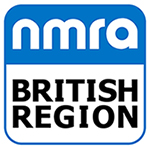Brian Moore describes how the Western Union group in Plymouth is taking model railroad operations to more prototypical levels
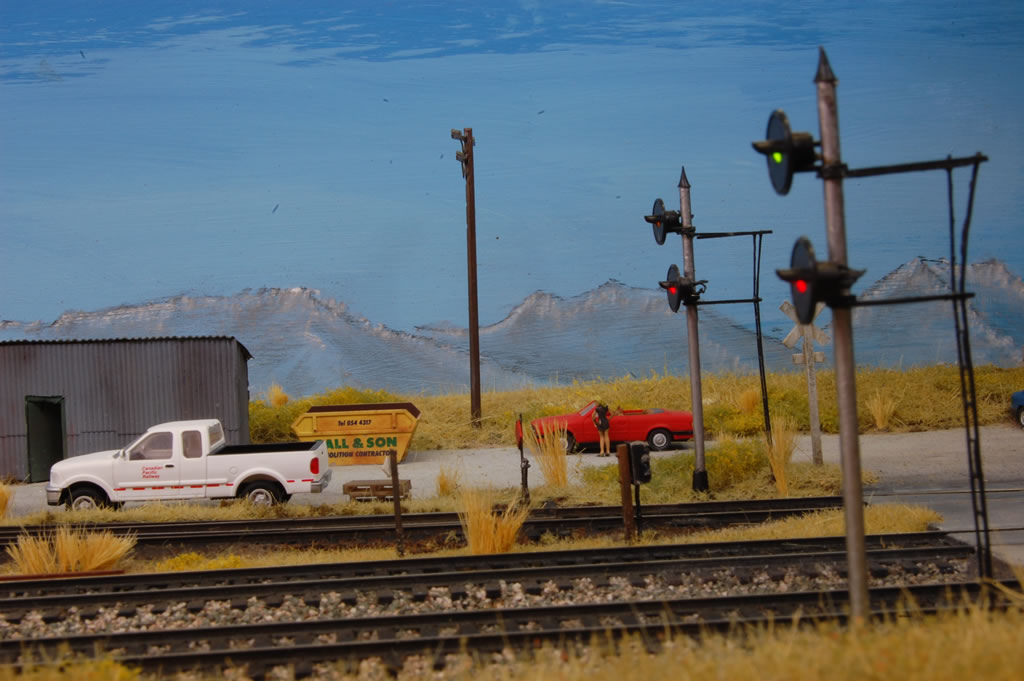 The Western Union’s HO club layout, Anson Yard, has been in steady development for several years, and presently comprises a straight 36 feet stretch of scenic boards, two sets of half-circle corners and a long seven-track storage yard on the other side of the oval. All storage tracks are capable of holding over 40 cars and several locomotives. The layout represents a reasonably modern secondary single-track line somewhere in the north west of the USA, and features a main line, a 32 foot passing siding, a three-track yard, a small MPD, two grain elevators served by two sidings, and a third siding which serves a small manufacturer. A branch line comes off the yard at the left-hand end, and there’s a helper pocket on the main line which is used to add additional power to heavy trains. A short MOW/team track siding is also present on the main line, and we’ve yet to decide if we’ll place a Depot nearby. The whole layout is transported using four cars and a trailer, and is erected every month at our meet in Hilltop Community Centre, Tamerton Foliot, in Plymouth. All stock is supplied by club members.
The Western Union’s HO club layout, Anson Yard, has been in steady development for several years, and presently comprises a straight 36 feet stretch of scenic boards, two sets of half-circle corners and a long seven-track storage yard on the other side of the oval. All storage tracks are capable of holding over 40 cars and several locomotives. The layout represents a reasonably modern secondary single-track line somewhere in the north west of the USA, and features a main line, a 32 foot passing siding, a three-track yard, a small MPD, two grain elevators served by two sidings, and a third siding which serves a small manufacturer. A branch line comes off the yard at the left-hand end, and there’s a helper pocket on the main line which is used to add additional power to heavy trains. A short MOW/team track siding is also present on the main line, and we’ve yet to decide if we’ll place a Depot nearby. The whole layout is transported using four cars and a trailer, and is erected every month at our meet in Hilltop Community Centre, Tamerton Foliot, in Plymouth. All stock is supplied by club members.
The scenic boards are owned and have been built by Steve Smith, the club owns the curves and the storage yard, Rob Mallett undertook a lot of scenic work and Brian Moore knocked together most of the buildings and structures. Mike Ruby, Peter Lloyd-Jones and Steve are responsible for the electronic and software side of things. The club has been running on DCC since 2002, and Anson Yard is controlled by a Lenz DCC set-up using the JMRI system; all main line and storage yard switches are operated from a laptop and are interlocked with fully operational light signals. The yard switches are also DCC-controlled, but from individual handsets to represent their real-life manually operated equivalents.
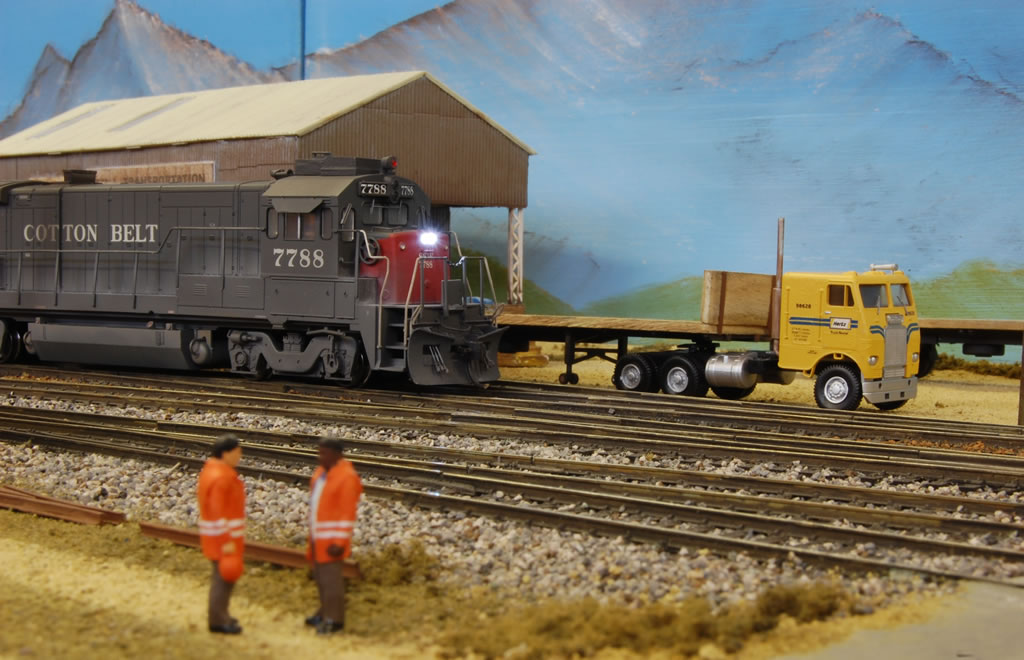 Every locomotive used on the layout is DCC and sound equipped, all feature correctly functioning light packages, and all have 28-step custom speed-curves. The stock represents a variety of scenarios, from block 40-car coal, grain and container trains to a multitude of boxcars of all descriptions. It‘s our firm opinion that you won’t find many layouts of this size that feature all of the above “this side of the pond”.
Every locomotive used on the layout is DCC and sound equipped, all feature correctly functioning light packages, and all have 28-step custom speed-curves. The stock represents a variety of scenarios, from block 40-car coal, grain and container trains to a multitude of boxcars of all descriptions. It‘s our firm opinion that you won’t find many layouts of this size that feature all of the above “this side of the pond”.
It became apparent to us that the layout just cried out to be run “properly”; to this end, we’re now developing prototypical operations using timetables and waybills, all controlled by a designated Dispatcher. We’ve been greatly influenced by the DVDs of Joe Fugate, and would strongly recommend that anyone who is interested in more prototypical running check these out – you won’t regret it: indeed, your views on club-sized model railroading may be transformed forever, once you have supped from this particular cup. Another prime source of information is the Kalmbach publication Realistic Model Railroad Operation by Tony Koester.
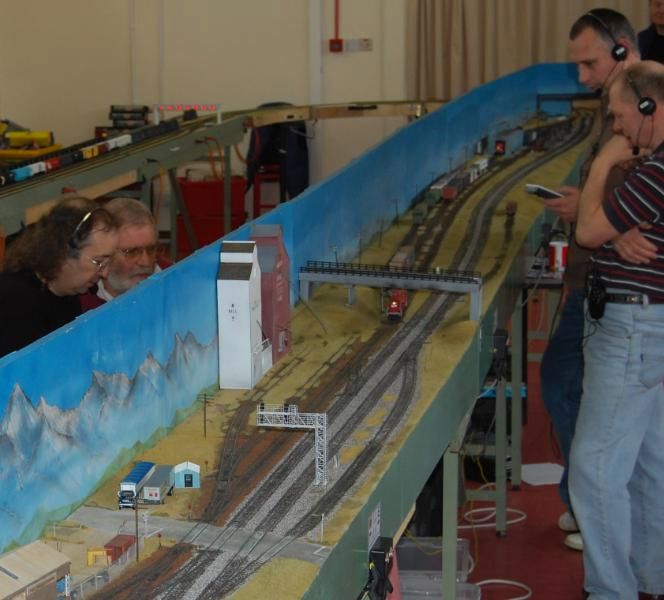 An essential tool for realistic operation is the two-way radio headset; the Dispatcher and anyone else operating on Anson Yard are required to wear one. By requiring all train orders, requests and movements to be passed through the clearing house of the controlling Dispatcher, we ensure that trains operate both prototypically and safely. This is done in conjunction with a set of written operating rules. On Anson, the Dispatcher is in charge of all main line running, plus storage tracks; additionally, he’s able to set specific routes involving the changing of many switches and signal lights through one click of the mouse on the laptop. The Dispatcher uses his headset to keep in two-way contact with engineers of all running trains, and they must seek instruction from him in connection with every move, as well as inform him of their progress – just like the real thing, as the Airfix box used to say. There’s also an Anson Yard Master job, and his task is to keep things flowing in the small yard and MPD; he has supervisory control over the Yard Switcher job, and they both work together as a team, again in conjunction with the Dispatcher. Both have headsets. The Yard Switcher can freely run anywhere within Yard Limits, but must request permission from the Dispatcher to venture onto the long siding track or the main line. Although we eventually aim to have a full timetable, we presently rely on the Dispatcher to call up available trains and allocate jobs as and when the need arises.
An essential tool for realistic operation is the two-way radio headset; the Dispatcher and anyone else operating on Anson Yard are required to wear one. By requiring all train orders, requests and movements to be passed through the clearing house of the controlling Dispatcher, we ensure that trains operate both prototypically and safely. This is done in conjunction with a set of written operating rules. On Anson, the Dispatcher is in charge of all main line running, plus storage tracks; additionally, he’s able to set specific routes involving the changing of many switches and signal lights through one click of the mouse on the laptop. The Dispatcher uses his headset to keep in two-way contact with engineers of all running trains, and they must seek instruction from him in connection with every move, as well as inform him of their progress – just like the real thing, as the Airfix box used to say. There’s also an Anson Yard Master job, and his task is to keep things flowing in the small yard and MPD; he has supervisory control over the Yard Switcher job, and they both work together as a team, again in conjunction with the Dispatcher. Both have headsets. The Yard Switcher can freely run anywhere within Yard Limits, but must request permission from the Dispatcher to venture onto the long siding track or the main line. Although we eventually aim to have a full timetable, we presently rely on the Dispatcher to call up available trains and allocate jobs as and when the need arises.
The Yard Switcher has active operational control of the “manual” yard turnouts via his Lenz 100 handset – this replicates the switchman’s job on a switching locomotive in the real world. Incoming and outbound locomotive engineers must also ensure that manual turnouts are correctly set (also via their handset) as they travel through the yard to designated sidings (under the orders of the Yard Master), so they also need to have personal control of the yard switches. Either the power on the incoming train or the Yard Switcher will pull or add allocated cars, following the instruction on each waybill and under the supervision of the Yard Master. Power can also be detached, changed and serviced in the MPD while the Yard Switcher attends to the train: co-ordination and mutual understanding are essential pre-requisites for this to take place without mishap or, just as importantly, short-circuit.
 It quickly became apparent that, if we’re to attempt prototypical running, every car that is to be individually moved or switched must have an allocated waybill. Therefore, incoming trains are pre-blocked in the storage yard, with any cars for switching in Anson Yard placed at the appropriate point of the train (usually the back or the front). Cars placed on any part of the scenic side at the start of a session are also given a waybill. However, not all cars on main line trains will require this paperwork, only those that are to be cut off in the yard or elsewhere. Several club members are now selecting cars to which they will allocate a specific waybill (including photograph), and a waybilled pool of about 60 cars of all descriptions is now available to switch and service the industries on (and off) the layout at each meet. This number is more than adequate for a “live” running session of 3-4 hours. Since all stock is removed from the layout at the end of each session, there’s no facility to “pick up where we left off”, as would occur on a permanently-erected layout at the start of another session, but this presents no problem.
It quickly became apparent that, if we’re to attempt prototypical running, every car that is to be individually moved or switched must have an allocated waybill. Therefore, incoming trains are pre-blocked in the storage yard, with any cars for switching in Anson Yard placed at the appropriate point of the train (usually the back or the front). Cars placed on any part of the scenic side at the start of a session are also given a waybill. However, not all cars on main line trains will require this paperwork, only those that are to be cut off in the yard or elsewhere. Several club members are now selecting cars to which they will allocate a specific waybill (including photograph), and a waybilled pool of about 60 cars of all descriptions is now available to switch and service the industries on (and off) the layout at each meet. This number is more than adequate for a “live” running session of 3-4 hours. Since all stock is removed from the layout at the end of each session, there’s no facility to “pick up where we left off”, as would occur on a permanently-erected layout at the start of another session, but this presents no problem.
Empty cars of various types are pulled from incoming trains, either to be spotted at points on the visible layout (elevators, MPD fuel, sand and supplies etc), or to be taken up the branch by the local to imaginary but “named” destinations. After a suitable amount of time has passed, a pre-blocked “new” branch train will be run from the inner storage loop back to Anson Yard, the power will cut off, and the yard switcher will follow the instructions on the waybills: cars will then be placed for eastbound or westbound collection by the next available train. Loads or empties for or from the visible portion of the layout are also dealt with in this way. More than one branch train can be run if desired, and there’s never any shortage of spare power in the MPD.
 The Yard Master and the Yard Switcher must work in tandem, and make best use of the small three-track facility. We’ve already found that too many inbound or outbound cars from or for a train can result in long delays for following operations, no matter how quick the Yard Switcher tries to classify them, so we try to limit things to a few cars at a time, as well as running block trains independently on the main to ensure that something is always moving. It’s not fully prototypical, but it keeps things enjoyable and fluid. “Through trains” (ie those that keep to the main line or Anson Siding, and do not enter the yard) are also under the Dispatcher’s control, and must also obey all signals, even if they just circulate around the layout. At times they will be required to stop at signals to facilitate a switching or other move, either on the main or siding, or from the storage yard. When a branch train is made up and ready to depart, the branch line Engineer, under radio orders from the Yard Master, will pick up his power in the MPD, start up the engines and ensure correct lights are displayed, connect with the fresh train that awaits him in an allocated siding, and haul the new loads back up the branch once he has cleared a route with the Dispatcher. And on it goes.
The Yard Master and the Yard Switcher must work in tandem, and make best use of the small three-track facility. We’ve already found that too many inbound or outbound cars from or for a train can result in long delays for following operations, no matter how quick the Yard Switcher tries to classify them, so we try to limit things to a few cars at a time, as well as running block trains independently on the main to ensure that something is always moving. It’s not fully prototypical, but it keeps things enjoyable and fluid. “Through trains” (ie those that keep to the main line or Anson Siding, and do not enter the yard) are also under the Dispatcher’s control, and must also obey all signals, even if they just circulate around the layout. At times they will be required to stop at signals to facilitate a switching or other move, either on the main or siding, or from the storage yard. When a branch train is made up and ready to depart, the branch line Engineer, under radio orders from the Yard Master, will pick up his power in the MPD, start up the engines and ensure correct lights are displayed, connect with the fresh train that awaits him in an allocated siding, and haul the new loads back up the branch once he has cleared a route with the Dispatcher. And on it goes.
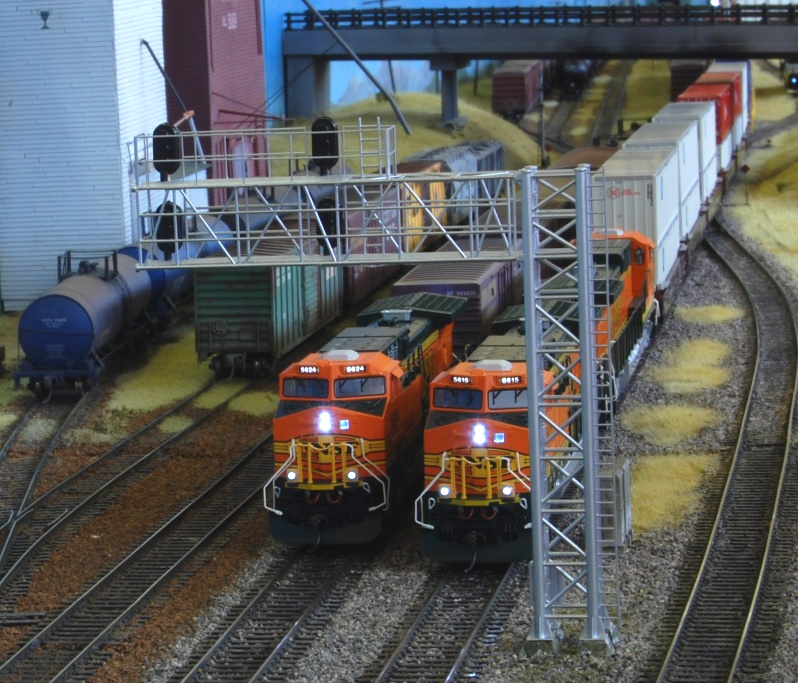 As can be ascertained, we’re only just beginning to discover how to do all of this, and we have so much more to learn. On a fully practical level, we’ll need to construct some boxes in which waybills can be placed, probably at the front of the actual yard where the cars and trains are switched – otherwise you end up placing the cards on the scenic baseboard itself; presently, a table placed below the layout does this job. What’s the point of creating an accurately scenicked yard if you then dump ten or so huge waybills down by the trackside, each the size of a 1/87 scale cricket pitch? All uncoupling is done manually, through the use of what we call Twizzle Sticks (Patent Pending) – shortened wooden barbecue skewers which are glued into the bodies of empty Bic or similar pens. I’m continually knocking up batches of these and they are great for the task, so much so that they gradually and mysteriously disappear into members’ stock boxes at each close of play. Like overdue library books, we have to have an amnesty every few months to get them back. Cut a small notch just below the point, in the manner of sharpening a pencil point with a knife, so that it’s slightly uneven when you twist it between the couplings – proper job, as they say in Devon.
As can be ascertained, we’re only just beginning to discover how to do all of this, and we have so much more to learn. On a fully practical level, we’ll need to construct some boxes in which waybills can be placed, probably at the front of the actual yard where the cars and trains are switched – otherwise you end up placing the cards on the scenic baseboard itself; presently, a table placed below the layout does this job. What’s the point of creating an accurately scenicked yard if you then dump ten or so huge waybills down by the trackside, each the size of a 1/87 scale cricket pitch? All uncoupling is done manually, through the use of what we call Twizzle Sticks (Patent Pending) – shortened wooden barbecue skewers which are glued into the bodies of empty Bic or similar pens. I’m continually knocking up batches of these and they are great for the task, so much so that they gradually and mysteriously disappear into members’ stock boxes at each close of play. Like overdue library books, we have to have an amnesty every few months to get them back. Cut a small notch just below the point, in the manner of sharpening a pencil point with a knife, so that it’s slightly uneven when you twist it between the couplings – proper job, as they say in Devon.
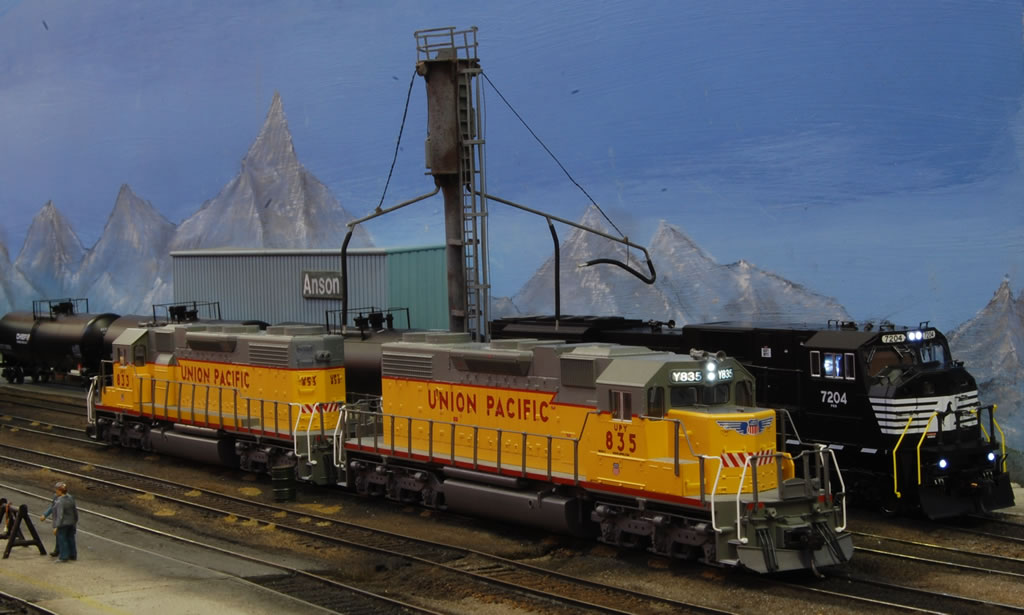 We thought that we’d be a smidge self-conscious when using the radios, particularly if you’re almost standing next to the person you’re communicating with, but this hasn’t been a problem – you also quickly get into the swing of using the lingo: Dispatcher, this is Extra 3047 Inbound Branch Local at signal number 7, requesting clearance to proceed into Anson Yard…Over… If you listen in to one of the many live links to the real thing you can find on the internet, you’ll quickly grasp that the discussions between the Dispatcher and Locomotive Engineer have a sort of “informal formality”: they use the correct terminology (naturally), but in a more chatty fashion than you would get, for example, in a police radio discussion. For complete accuracy, it would appear that we require a Dispatcher who can replicate the polite mid-western tones of a female in her mid-thirties, but until then, the manly Plymothian burr of the likes of Mr Mike Ruby will have to suffice. Have a safe day, y’all. Pasty anyone?
We thought that we’d be a smidge self-conscious when using the radios, particularly if you’re almost standing next to the person you’re communicating with, but this hasn’t been a problem – you also quickly get into the swing of using the lingo: Dispatcher, this is Extra 3047 Inbound Branch Local at signal number 7, requesting clearance to proceed into Anson Yard…Over… If you listen in to one of the many live links to the real thing you can find on the internet, you’ll quickly grasp that the discussions between the Dispatcher and Locomotive Engineer have a sort of “informal formality”: they use the correct terminology (naturally), but in a more chatty fashion than you would get, for example, in a police radio discussion. For complete accuracy, it would appear that we require a Dispatcher who can replicate the polite mid-western tones of a female in her mid-thirties, but until then, the manly Plymothian burr of the likes of Mr Mike Ruby will have to suffice. Have a safe day, y’all. Pasty anyone?
As said, it’s very early days, and we will, no doubt, make some mistakes as we embark on this journey. What we can tell you is that the effort is wholly worthwhile. This sort of thing can only come about when like-minded people work together and are willing to learn new tricks and/or operate trains in a different way by developing a variety of new skills. Rules have to be created and adhered to. For club members who prefer to run trains only on the main, the facility will still exist to do this, but all trains must still be under the control of the Dispatcher, and can only be run with possession of a radio set. Even if constantly circling the layout with his train, the Operator will still have to be constantly vigilant of the signals and expectant of instruction from the Dispatcher. We plan to install light signals on the storage yard exits, so that trains can be controlled visually on every part of the layout, and moves are also afoot to upgrade the curved corner boards and the backscenes. We are also aware of the need to place some working dwarf signals at a couple of places on the layout too, and wireless handheld controllers would, of course, make things almost perfect.
Everyone who’s taken part in these early sessions will tell you just how enjoyable they’ve been, despite the hiccups and learning pains. Usually, at the end of a meet, what with the early rise, car loading and unloading, heavy lifting, setting up and breaking down etc, we’re mostly quite happy not do it all again for another month. Now, most of us would do it again the next day in a flash, so that we can have yet more fun running trains closer to the real thing than ever before. You can’t have a better indication than that of how Dispatcher and radio-controlled operations can really transform a meet. It could do the same for yours too.
